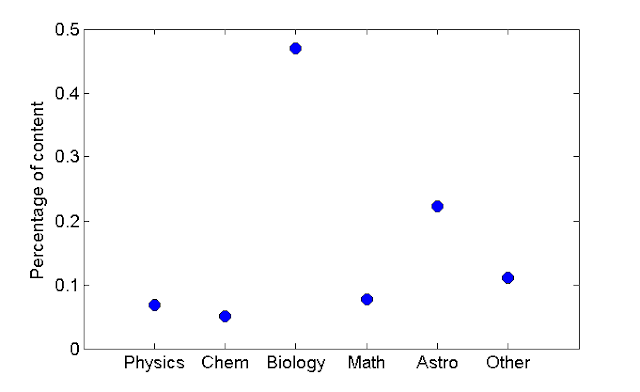A study of Google search results to understand the public's perspective of chemistry
Chad Jones
The Collapsed Wavefunction
Chad Jones
The Collapsed Wavefunction
Abstract
This article is presented (at least in part) as a tongue-in-cheek look at the public's perspective of chemistry. Chemistry bloggers often remark that chemistry is poorly featured in mainstream science communication. To assess the validity of this claim a Google search results experiment was performed. This experiment showed that chemistry fairs just about as well as physics and biology. To further test the claim, content on the social media webpage "I F***ing Love Science" was analyzed and categorized by discipline. This study shows a high bias towards biology and astronomy on IFLS.
Introduction
Whether or not the chemistry is a well appreciated science among the general public is a topic of recent debate among the online chemistry community. Oh et al. have pointed out [1] that no chemists are mentioned in WIRED Magazine's "101 Signals", which lists the "...best reporters, writers, and thinkers on the Internet". This oversight has restarted a common theme among chemistry bloggers: How is chemistry perceived by the general public?[2][3][4][5]
The experiment herein described was performed as an attempt to quantitatively answer that question. Specifically, it has been designed to test the accessibility and visibility of chemistry as compared to other disciplines. For the purposes of this study "accessible" is defined as "perceived as being easily understood" and "visible" is defined as "featured often in popular culture". Thus a discipline that is both accessible and visible is one that is seen often by the public and is thought of as being easy to understand. The results of this study should be used to shape the future actions of chemistry advocates. If chemistry as a discipline is indeed seen as inaccessible to the general public then specific efforts are needed to make topics in chemistry more accessible. On the other hand, if the science is accessible but not visible then efforts should be focusing on spreading chemistry as it is already presented.
Methods
To assess the public's opinion of chemistry as a whole a Google search experiment was designed. This experiment is designed to take a comparative look on how chemistry is perceived. First, negative search phrases were used for a variety of science disciplines (physics, chemistry, biology, math, and astronomy). The number of search results for each discipline were recorded and normalized to represent a percentage of total search results. Next, positive search phrases were used for the same disciplines. The data were normalized in a similar fashion. Error bars on each result represent a single standard deviation from the average percentage of total search results. While simply counting the number of search results does not perfectly correlate to how people feel about a given subject, it is a good first approximation.
Negative search phrases used:
"...is stupid"
"I hate…"
"…is wrong"
"…is hard"
"I failed…"
"I can't stand…"
"I don't like…"
"…is dumb"
"I'm too stupid for…"
"I don't understand…"
"…isn't useful"
"…is dangerous"
Positive search phrases used:
"…is awesome"
"…is great"
"…is fun"
"…is useful"
"…is my favorite
"I love…"
"I like…"
"…is the best"
Results and discussion
Figure 1 shows the distribution of negative search results. If chemistry were seen as an inaccessible subject one would expect chemistry to have a higher percentage of negative search results. Instead we see that chemistry, physics, and biology all have about the same number of negative search results while astronomy has a very low negative search result. Math has a very high negative search results. This places math as a very inaccessible discipline.

|
| Figure1 - Distribution of negative search results |
Figure 2 shows the distribution of positive search results. If chemistry were not a visible discipline one would expect low positive results. These results, however, show that chemistry is as popular as physics and astronomy. Biology is slightly less popular while math is slightly more popular. It is interesting to notice that math scored high in both positive and negative search results.

|
| Figure 2 - Distribution of positive search results |
Figure 3 plots the percentage of content on IFLS with respect to discipline. It is automatically apparent that IFLS shows a high bias to biology and astronomy while featuring very little physics, math, and chemistry by comparison.

|
| Figure 3 - IFLS content |
While IFLS is by no means a perfect snapshot of the public's interest, it is a reasonable representation of how an educated general audience feels about science. It should be stated that IFLS has a very large audience. Pictures and comments on the site are spread widely throughout Facebook and other social media. It would be in the interest of chemistry advocates to appeal to Elise Andrew, author of the blog, for more chemistry content.
Conclusion
The author of this study readily admits its limitations. It should not be seen as a final say in this discussion. Instead its purpose is to bring a quantitative look at a real problem. Our goal, as science communicators, should be to make our discipline both accessible and visible.
Acknowledgments: The author would like to acknowledge the irony of contributing such a formal article to the discussion about the accessibility of online chemistry education . . .
As this article is being submitted for peer review, I welcome criticisms that go along with that process. If you have new search phrases you think should be included or any other modifications please comment and I will update the results.
